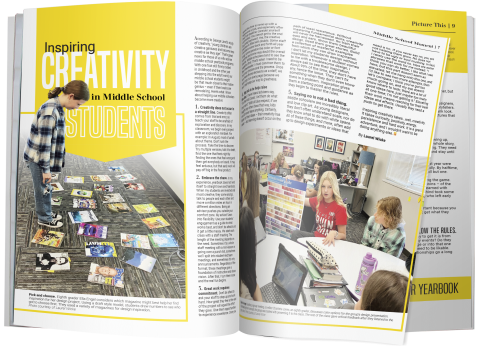According to George Land’s study of creativity, “young children are creative geniuses and become less creative as they age.” That’s great news for those of us who advise middle school yearbook programs. With one foot still firmly rooted in childhood and the other just stepping into the adult world, our middle school students might be that much closer to their native genius – even if their brains are remodeling. Here’s what I know about helping our middle schoolers become more creative:
1. Creativity does not occur in a straight line. Creativity often comes from trial and error, so teach your staff to be unafraid of exploration and discovery. In my classroom, we begin every project with an exploration mindset. For example: In August, most of us talk about theme. Don’t rush the process. Take the time to discover. Try multiple versions, talk it to death, find the one that feels right by finding the ones that feel wrong and then get everybody on board. It may feel arduous, but that early work will pay off big in the final product.
2. Embrace the chaos. In my experience, yearbook does not lend itself to straight rows and handouts. When my students are invested and most creative, they come and go, talk to people and each other and move a million miles an hour in different directions. Being an adviser pushes you outside your comfort zone. My advice? Lean into flexibility. Use your students’ engagement as a guide to what works best, and don’t be afraid to let it get a little messy. We start each class with a staff meeting. The length of the meeting depends on the need. Sometimes it’s a whole staff meeting with a mini-lesson or going over a punch list, sometimes we’ll split into student-led team meetings, and sometimes it’s only announcements. Regardless of the format, these meetings give a foundation of instruction and share vision. After that, I turn them loose and the real fun begins.
3. Great work requires commitment. Don’t be afraid to ask your staff to step up and work hard. How great they feel at the end of the project will equal the effort they gave. Give them opportunities to experience excellence. Once you spend the time to come up with a theme and a look, and especially after that first deadline, consider yourself committed. You cannot get to the end by going backward. Yes, the creative process is filled with doubts. Some staff members waver back and forth all year long, some question the color or font choices and some may doubt the overall theme. Middle schoolers tend to see the negative first. That’s when I need to be the cheerleader. I must convince them to trust our choices and the process. Once we make those decisions as a staff, we lean into it on every page because we can’t half-step our way to greatness.
4. My job is to help raise the bar. I have heard advisers say, “It’s the kids’ book; I let them do what they want.” With all due respect, if we taught any other class that way, kids would never learn anything. Certainly, listen to their ideas – their creativity has value – but learning doesn’t occur on the path of least resistance. Without mastering fundamental skills, creativity will never be harnessed. So train their eyes and ears. Show them beautiful design. Read them great stories. Build a collection of masterful examples from which they can draw inspiration. I don’t let my students design without inspiration. Whenever a student comes to me with a troublesome design, I always ask to see their inspiration. About 99% of the time, they don’t have any, hence the issue. They can’t fix something when they don’t even know there is a problem. Inspiration gives them a starting point and guidance as they begin to master the rules.
5. Saying no is not a bad thing. Middle schoolers are incredibly literal and love clip art. As young designers, they don’t often understand scale, nor do they know what to do with white space.
All of these things, and more, often add up to design experiments or ideas that need a no. If you never say no, you are not helping them grow. No does not have to be ugly or soul crushing. In fact, I rarely use the word no. Here are some phrases that work for me instead: “I think you can do better; I like what I see here, but this part doesn’t seem as elevated; let me hang onto this one, and I’d like to see two more attempts, then let’s compare; I think you’ve got too much going on, and my eye doesn’t know where to look; there are a lot of good ideas here, just maybe too many at one time; I’m not getting it.” Elevating their work means reaching for their best ideas and efforts. Usually they need a push to get there.
Inspiring creativity takes…well, creativity. It takes curiosity, positivity, energy, persistence and hard work. It is a grand adventure, and I wouldn’t want to be doing anything else.
Want to read more timely topics related to yearbook? Take a look at the fall Idea File magazine online to see different stories focused on how to make your yearbook the best it can be.





